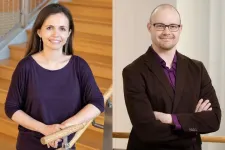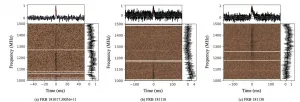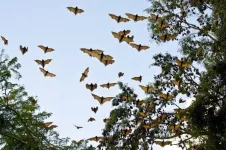(Press-News.org) CHAMPAIGN, Ill. -- Charitable donations account for about 2% of gross domestic product in the U.S., but it's not well-understood whether an event such as a deadly storm inspires increases in charitable giving or simply reallocates a fixed supply of donation dollars that would have otherwise gone to another cause.
A new paper from a team of University of Illinois Urbana-Champaign experts finds that, in the aftermath of catastrophic tornadoes, charitable giving to alleviate an unanticipated event doesn't necessarily crowd out monetary donations to other causes.
Research co-written by Tatyana Deryugina and Benjamin M. Marx uses comprehensive annual tax return data to estimate whether discrete but destructive events such as fatal tornadoes increase total charitable giving.
The paper, which will be published in the journal American Economic Review: Insights, finds that each tornado fatality increases total donations from individuals living nearby by almost $2 million.
"There is an active debate in the research on charitable giving on the extent of donor substitution between charitable causes," said Deryugina, a professor of finance at Illinois. "By employing a natural experiment with both geographic and temporal variation as well as datasets that contain the majority of dollars donated across the U.S., our paper can rule out the possibility that individuals choose a set amount to donate to charity and then apportion that amount among charities."
The researchers measured charitable giving from 2002-17 using ZIP code-level individual income tax data from the Internal Revenue Service, which reports all income tax deductions claimed for donations to any registered charity.
By combining the IRS data with geospatial information on the incidence of tornadoes, the researchers were able to zero in on the destruction wrought by lethal tornadoes, allowing them to identify events that affected populated areas and caused tens of millions of dollars' worth of damage.
"We looked at tornadoes because they hit a very specific and limited area, which gives us a treatment area and a clean control area so we can get better estimates via comparison," said Marx, a professor of economics at Illinois.
Deryugina and Marx found that lethal tornadoes significantly increased total charitable donations from individuals living at least 20 miles away in the same state from a tornado's path by almost $2 million per fatality.
"We excluded ZIP codes that were within 20 miles of the tornado's path, so we weren't looking at the places that were directly affected by property damage or loss of life," Marx said. "We went outside of that 20-mile ring and out to the rest of the state to estimate the effect on average giving in those other ZIP codes. And if you add up those effects across all of those ZIP codes, you arrive at a total state-level effect, which is where the $2 million figure comes from."
Because total giving increases, the scholars were able to rule out perfect substitution between charitable causes and conclude that the supply of donations from an "altruism budget" can expand given exigent circumstances, Deryugina said.
"We can't rule out that there's some marginal crowding-out effects, because we just find that total giving goes up, but I'm comfortable speculating that there's not a lot of substitution because the total increase is fairly large," she said. "If there is some substitution, it's not huge. Basically, we see no evidence for the existence of a radical pullback in charitable giving to other causes after these natural disasters."
Using annual tax return data from charities, the researchers also found that there were no significant negative effects on charities in the locations from which increased donations to fatal tornadoes originated.
"That implies that giving in response to new needs doesn't come at the expense of these other causes," Marx said.
Charitable giving for natural disasters is common, with a nationally representative survey indicating that about 30% of U.S. households donated money in 2017-18. While the data in the paper covered the majority of dollars donated, it may not be representative of lower-income households, whose charitable donation budget may be more fixed, the researchers said.
"We only had aggregate, ZIP code-level data. We would have loved to break it down by income group, but we just didn't have the data," Deryugina said. "We do note in the paper that most charitable giving in the U.S. is by wealthier people. Lower-income individuals and households are less likely to file taxes, and all of our data came from the IRS. So our estimates are representative of individuals who filed a tax return, but those individuals make up a sizable share of total charitable giving."
INFORMATION:
The research was supported by the Lilly Family School of Philanthropy.
Millions of people die prematurely every year from diseases and cancer caused by air pollution. The first line of defence against this carnage is ambient air quality standards. Yet, according to researchers from McGill University, over half of the world's population lives without the protection of adequate air quality standards.
Air pollution varies greatly in different parts of the world. But what about the primary weapons against it? To find answers, researchers from McGill University set out to investigate global air quality standards in a study published ...
The idea was so far-fetched it seemed like science fiction: create an observatory out of a one cubic kilometer block of ice in Antarctica to track ghostly particles called neutrinos that pass through the Earth. But speaking to Benedickt Riedel, global computing manager at the IceCube Neutrino Observatory, it makes perfect sense.
"Constructing a comparable observatory anywhere else would be astronomically expensive," Riedel explained. "Antarctica ice is a great optical material and allows us to sense neutrinos as nowhere else."
Neutrinos are neutral subatomic particles with a mass close to zero that can pass through solid materials at near the speed of light, rarely reacting with normal matter. They were first detected in the 1950s in experiments that operated ...
Scientists using NASA's Hubble Space Telescope have found evidence that a planet orbiting a distant star may have lost its atmosphere but gained a second one through volcanic activity.
The planet, GJ 1132 b, is hypothesized to have begun as a gaseous world with a thick hydrogen blanket of atmosphere. Starting out at several times the diameter of Earth, this so-called "sub-Neptune" is believed to have quickly lost its primordial hydrogen and helium atmosphere due to the intense radiation of the hot, young star it orbits. In a short period of time, such a planet would be stripped down to a bare core about the size of Earth. That's when things got interesting.
To the surprise of astronomers, Hubble observed an ...
ROCHESTER, Minn. -- Ten days after receiving a second dose of a messenger RNA, or mRNA, vaccine for COVID-19, patients without COVID-19 symptoms are far less likely to test positive and unknowingly spread COVID-19, compared to patients who have not been vaccinated for COVID-19. The Pfizer-BioNTech and Moderna messenger RNA vaccines for COVID-19 are authorized for emergency use in the U.S.
With two doses of a messenger RNA COVID-19 vaccine, people with no symptoms showed an 80% lower adjusted risk of testing positive for COVID-19 after their last dose. Those are the findings of a Mayo Clinic study of vaccinated patients. These finding appear in the journal Clinical Infectious Diseases.
The authors say these findings underscore ...
A study conducted by researchers at the University of Rochester Medical Center (URMC) - in collaboration with several other universities - indicates that breastfeeding women with COVID-19 do not transmit the SARS-CoV-2 virus through their milk, but do confer milk-borne antibodies that are able to neutralize the virus.
The study, "Characterization of SARS-CoV-2 RNA, antibodies, and neutralizing capacity in milk produced by women with COVID-19," published on February 9 in the journal mBio - analyzed 37 milk samples submitted by 18 women diagnosed with COVID-19. None of the milk samples were found to contain ...
Fast radio burst (FRB) is a kind of mysterious radio flashes lasting only a few thousandths of a second. Confirmed to be the cosmological origin in 2016, FRB has the potential to provide insights into a wide range of astrophysical problems.
Dr. NIU Chenhui from the team led by Dr. LI Di and Dr. ZHU Weiwei from National Astronomical Observatories of Chinese Academy of Sciences discovered three new FRBs with high dispersion measure from the massive data of the Five-hundred-meter Aperture Spherical radio Telescope (FAST).
Their findings were published in The Astrophysical Journal Letters on March 3.
The discovery indicated that these three FRBs happened billions of years ago when the ...
Intrauterine growth restriction (IUGR) is common and concerning, but few therapeutic options exist for pregnant mothers who receive this diagnosis. IUGR is a condition in which a baby in the womb is measuring small for its gestational age, often because of issues with the placenta, resulting in compromised or insufficient transfer of oxygen and nutrients to the growing fetus. The developing fetal brain is particularly vulnerable to these effects. One out of every 10 babies is diagnosed with IUGR, and infants with IUGR are at increased risk of death and neurodevelopmental impairment. ...
Biologists from RUDN University suggested adding a marjoram-based supplement to the diet of common carp to support the growth of the fish and improve their resistance to bacterial infections. The results of the study were published in the Fish & Shellfish Immunology journal.
Cyprinus carpio is a type of large omnivore fish that grows 35-40 cm long in three to five years. 4 mln tons of carps were bred in aquacultural farms in 2010. Such farms protect natural populations of Cyprinus carpio while at the same time satisfying the market demand. However, as farmers strive for higher productivity, aquacultural farms become more and more crowded which leads to the lack of nutrients and harms the health of the fish. A team of veterinarians ...
CABI scientist Dr Arne Witt has shared his expertise on invasive alien plant species as part of a new paper which argues that healthy ecosystems are vital in reducing the risk of future pandemics - such as coronaviruses (including COVID-19) - that threaten human health.
The paper - 'Land use-induced spillover: priority actions for protected and conserved area managers' - is published as part of a special issue by the journal PARKS entitled 'COVID-19 and Protected Areas: Essential Reading for a World Haunted by a Pandemic.'
Lead author Dr Jamie K. Reaser - along with a team of researchers from institutions including the African Wildlife Foundation, the University ...
Exposure to SARS-Co-V2, the virus that causes COVID-19, can put otherwise healthy children and adolescents at risk for Multisystem Inflammatory Syndrome in Children (MIS-C), a rare but possibly life-threatening pediatric condition that can cause severe inflammation in organs like the heart, brain, lungs, kidneys and gastrointestinal system.
Diagnosing and treating MIS-C -- which has affected 2,600 children since May 2020 and is known to occur in children who have tested positive for SARS-Co-V2 or been exposed to someone with COVID-19 -- is difficult because respiratory and gastrointestinal symptoms can be similar to severe COVID-19. Other features of MIS-C are very similar to Kawasaki disease, which causes inflammation ...




